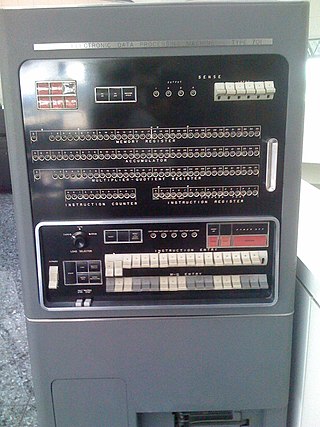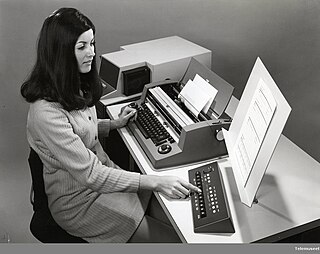
Disk storage is a data storage mechanism based on a rotating disk. The recording employs various electronic, magnetic, optical, or mechanical changes to the disk's surface layer. A disk drive is a device implementing such a storage mechanism. Notable types are hard disk drives (HDD), containing one or more non-removable rigid platters; the floppy disk drive (FDD) and its removable floppy disk; and various optical disc drives (ODD) and associated optical disc media.

The IBM System/360 (S/360) is a family of mainframe computer systems that was announced by IBM on April 7, 1964, and delivered between 1965 and 1978. It was the first family of computers designed to cover both commercial and scientific applications and a complete range of applications from small to large. The design distinguished between architecture and implementation, allowing IBM to release a suite of compatible designs at different prices. All but the only partially compatible Model 44 and the most expensive systems use microcode to implement the instruction set, featuring 8-bit byte addressing and fixed point binary, fixed point decimal and hexadecimal floating-point calculations.

A tape drive is a data storage device that reads and writes data on a magnetic tape. Magnetic-tape data storage is typically used for offline, archival data storage. Tape media generally has a favorable unit cost and a long archival stability.

The IBM 701 Electronic Data Processing Machine, known as the Defense Calculator while in development, was IBM’s first commercial scientific computer and its first series production mainframe computer, which was announced to the public on May 21, 1952. It was designed and developed by Jerrier Haddad and Nathaniel Rochester and was based on the IAS machine at Princeton.
In computing, end-of-file (EOF) is a condition in a computer operating system where no more data can be read from a data source. The data source is usually called a file or stream.
In computing, a removable media is a data storage media that is designed to be readily inserted and removed from a system. Most early removable media, such as floppy disks and optical discs, require a dedicated read/write device to be installed in the computer, while others, such as USB flash drives, are plug-and-play with all the hardware required to read them built into the device, so only need a driver software to be installed in order to communicate with the device. Some removable media readers/drives are integrated into the computer case, while others are standalone devices that need to be additionally installed or connected.
In computer science, group coded recording or group code recording (GCR) refers to several distinct but related encoding methods for representing data on magnetic media. The first, used in 6250 bpi magnetic tape since 1973, is an error-correcting code combined with a run-length limited (RLL) encoding scheme, belonging into the group of modulation codes. The others are different mainframe hard disk as well as floppy disk encoding methods used in some microcomputers until the late 1980s. GCR is a modified form of a NRZI code, but necessarily with a higher transition density.
In computing, mass storage refers to the storage of large amounts of data in a persisting and machine-readable fashion. In general, the term "mass" in "mass storage" is used to mean "large" in relation to contemporaneous hard disk drives, but it has also been used to mean "large" relative to the size of primary memory as for example with floppy disks on personal computers.

Linear Tape-Open (LTO), also known as the LTO Ultrium format, is a magnetic tape data storage technology used for backup, data archiving, and data transfer. It was originally developed in the late 1990s as an open standards alternative to the proprietary magnetic tape formats that were available at the time. Upon introduction, LTO rapidly defined the super tape market segment and has consistently been the best-selling super tape format. The latest generation as of 2021, LTO-9, can hold 18 TB in one cartridge.

The IBM 729 Magnetic Tape Unit was IBM's iconic tape mass storage system from the late 1950s through the mid-1960s. Part of the IBM 7-track family of tape units, it was used on late 700, most 7000 and many 1400 series computers. Like its predecessor, the IBM 727 and many successors, the 729 used 1⁄2 inch (13 mm) magnetic tape up to 2,400 feet (730 m) long wound on reels up to 10+1⁄2 inches (270 mm) diameter. To allow rapid tape acceleration, long vacuum columns were placed between the tape reels and the read/write heads to absorb sudden increases in tape tension which would otherwise break the tape. Write protection was provided by a removable plastic ring in the back of the tape reel.
The 3480 tape format is a magnetic tape data storage format developed by IBM. The tape is one-half inch (13 mm) wide and is packaged in a 4 in × 5 in × 1 in cartridge. The cartridge contains a single reel; the takeup reel is inside the tape drive.

The IBM MT/ST was a model of the IBM Selectric typewriter, built into its own desk, integrated with magnetic tape recording and playback facilities, located in an attached enclosure, with controls and a bank of relays. It was released by IBM in 1964. It recorded text typed on 1/2" magnetic tape, approximately 25 kilobytes per tape cassette, and allowed editing and re-recording during playback. It was the first system marketed as a word processor. Most models had two tape drives, which greatly facilitated revision and enabled features such as mail merge. An add-on module added a third tape station, to record the combined output of playback from the two stations.
The Massbus is a high-performance computer input/output bus designed in the 1970s by Digital Equipment Corporation (DEC). The architecture development was sponsored by Gordon Bell and John Levy was the principal architect.

IBM's first magnetic-tape data storage devices, introduced in 1952, use what is now generally known as 7-track tape. The magnetic tape is 1⁄2 inch (13 mm) wide, and there are six data tracks plus one parity track for a total of seven parallel tracks that span the length of the tape. Data is stored as six-bit characters, with each bit of the character and the additional parity bit stored in a different track.

9-track tape is a format for magnetic-tape data storage, introduced with the IBM System/360 in 1964. The 1⁄2 inch (12.7 mm) wide magnetic tape media and reels have the same size as the earlier IBM 7-track format it replaced, but the new format has eight data tracks and one parity track for a total of nine parallel tracks. Data is stored as 8-bit characters, spanning the full width of the tape. Various recording methods have been employed during its lifetime as tape speed and data density increased, including PE, GCR, and NRZI. Tapes come in various sizes up to 3,600 feet (1,100 m) in length.
Magnetic-tape data storage is a system for storing digital information on magnetic tape using digital recording.
The IBM 3570 is a series of tape drives and corresponding magnetic tape data storage media formats developed by IBM. The storage technology and media were introduced using the name Magstar MP, combining the IBM storage brand name Magstar with MP for MultiPurpose. The IBM product number 3570 was associated with the tape drives and libraries that used the Magstar MP media.
Tape labels are identifiers given to volumes of magnetic tape.
The IBM 7340 "Hypertape" system was a magnetic tape data storage format designed to work with the IBM 7074, 7080 and 7090 computers that was introduced in 1961 and withdrawn in 1971.








